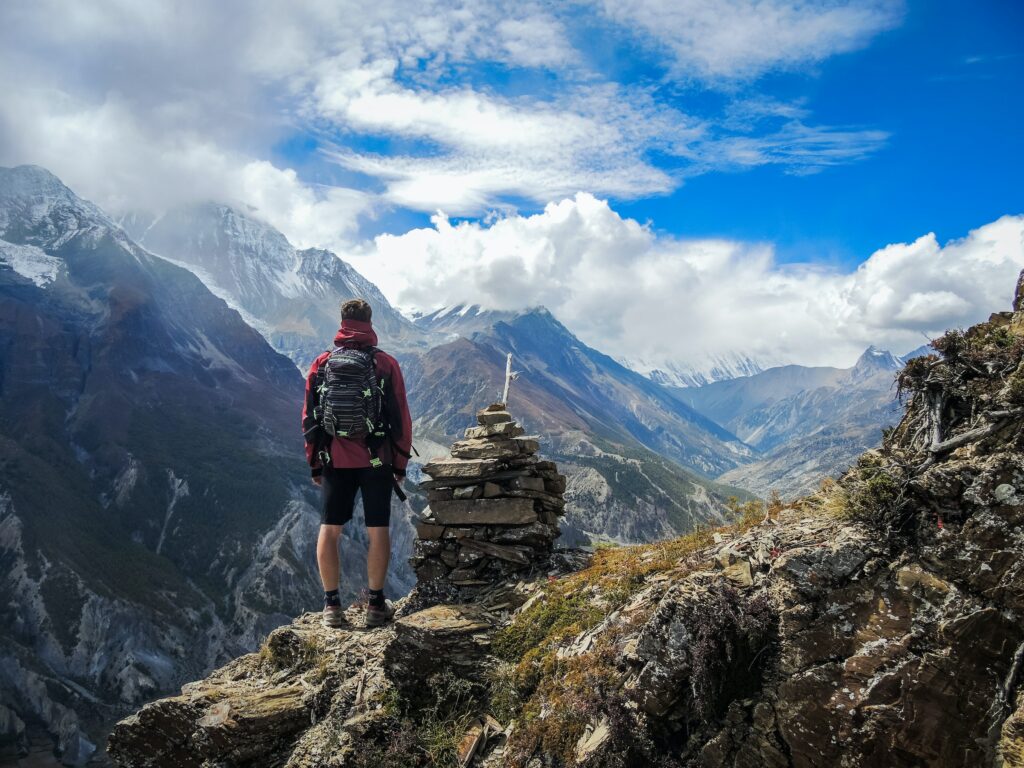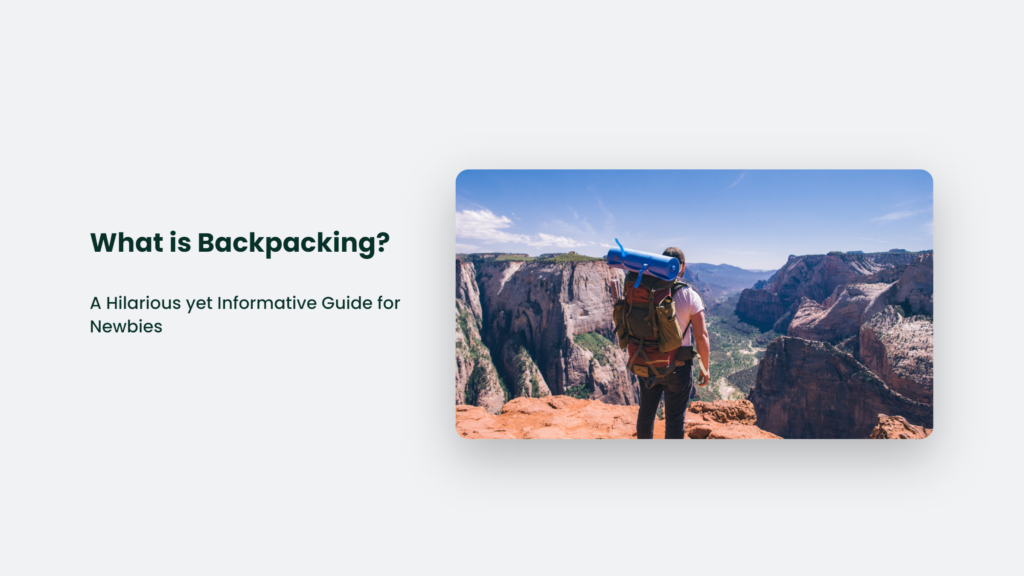

What is Backpacking? A Hilarious yet Informative Guide for Newbies

As Seen On
Backpacking.
For some, the word conjures up images of carefree young people traipsing around Europe with oversized backpacks. For others, it means multi-day hiking and camping trips into the wilderness.
And for a few lucky bastards, backpacking simply means not having to check a bag on their next flight.
But what is backpacking, actually? And how the hell do you get started with it?
Well, strap on your hiking boots and grab your water filter because we’re about to cover all that and more in this beginner’s guide to backpacking.

What is Backpacking?
Backpacking is essentially multi-day hiking while carrying all your camping gear on your back.
Unlike car camping, where you can bring a literal kitchen sink, backpacking forces you to pare down your gear to only the essentials.
Your entire life has to fit into a backpack weighing 20-40 lbs. So, you can imagine it takes some adjustment from your regular 100-item beauty regimen.
But the payoff is getting to experience nature in a way you simply can’t by day hiking or car camping. You feel more immersed and free to roam wherever your feet take you.
It’s you, your backpack, and the trail. Pure bliss.Backpacking appeals to the inner minimalist in all of us. The sheer simplicity of living out of one bag is refreshing.
You realize just how little you actually need to survive and be content.
Backpacking for Beginners: How to Get Started
Curious about backpacking but intimidated to take the plunge? Don’t sweat it. Here’s a step-by-step guide to get you started:
Step 1: Start Small and Local
The biggest mistake first-time backpackers make is biting off more than they can chew.
Attempting a multi-day backcountry excursion as your first trip is a recipe for misery.
Instead, start with an overnight trip somewhere close by. That way, if you forget something critical (you will) or the reality of sleeping on the ground hits you like a ton of bricks (it might), you can bail and be home in a few hours.
Consider camping at an established backcountry campsite with access to water and restrooms. State and national parks are perfect for beginner trips.
You can gradually increase the distance and nights as you get a feel for the gear and pace.
Step 2: Dial in Your Gear
Having the right backpacking gear makes all the difference between a trip being a dream or a nightmare.
Start by making a checklist of essentials like a backpack, shelter, sleep system, cookware, and clothes. Prioritize quality over cost.
Next, hit up an outdoor retailer like REI and try stuff on. Backpacks especially need to fit your torso and waist correctly.
Don’t buy version 1.0 of everything, either. Start with affordable starter gear and upgrade pieces over time.
Lastly, pack a trial run a few weeks before your trip and spend a night in the backyard. You’ll quickly find out what’s missing.
Step 3: Get into Backpacking Shape
Backpacking is a physical activity. Those heavy packs don’t carry themselves uphill.
Training your body ahead of time will make the miles much more enjoyable.
Focus on cardio endurance, like going on long hikes with a weighted daypack. Strength training your legs and core is also key. The stronger you are, the lighter that pack will feel.
And don’t forget to break in those new boots! Blisters make or break a trip.
Step 4: Learn Backcountry Skills
To travel safely in the backcountry, you need a specific skill set.
Start by learning how to:
- Use a topographic map and compass for navigation.
- Purify water from natural sources.
- Cook on a lightweight camp stove
- Hang a bear bag to protect your food
- Field dress first aid issues like blisters or sprains
Consider taking a class or taking a guided trip to learn these skills. REI offers a wide range of instructional clinics.
You don’t have to master everything before your first trip, but the more competent you are, the more fun you’ll have.
Step 5: Plan Your First Backpacking Route
Choosing a suitable route is critical for first-timers. Consider these factors when planning:
- Distance: Start with 5-7 miles per day max.
- Elevation gain – Look for relatively flat terrain
- Water sources – Lakes and rivers are ideal
- Permits – Some parks require permits for backcountry camping
- Bailout points – Pick trails with quick exit points
Use AllTrails or Gaia GPS apps to find established trails that meet your criteria.
Vet any first aid concerns and bring maps as backup. The more prepared you are, the more you’ll enjoy yourself.
Backpacking Gear List: The 10 Essentials
Want to know what to pack for backpacking? Here are the 10 essential gear items every backpacker needs:
Backpack
Your pack carries all your gear, so get one properly fitted to your torso length and waist size. Shoot for 30-50 liters capacity for 1-3 night trips.
Shelter
Tents, tarps, hammocks, etc. Just make sure it’s lightweight, weatherproof, and fits you plus your gear.
Sleep System
A sleeping bag and sleeping pad. You want insulation from the cold ground plus warmth rated for the low temps expected.
Cookset
Pot, stove, lighter, and utensils. You need a way to boil water for meals and purification.
Water Treatment
Filter, purifier, or chemicals to make natural water sources potable and prevent illness.Food
Highly caloric backpacking meals and snacks.
Calculate about 1-1.5 lbs per person per day.
Lighting
Headlamp for night hiking, camp tasks, and backup battery or extra batteries.
Navigation
Map, compass, GPS device/app, and personal locator beacon if going deep into the backcountry.
First Aid Kit
Bandages, ointments, medications, tools, etc., to treat minor injuries and ailments.
Fire Starter
Matches, lighters, fire starters. Useful for lighting stoves, minimizing campfire impact, and emergencies.
Frequently Asked Questions:
How much does it cost to get started backpacking?
Expect to spend $300-$800 on essential gear items like backpack, tent, sleeping bag, etc. Go used or rent gear to save money initially.
How heavy should my pack be?
Aim for no more than 20-30% of your body weight. So a 150 lb person’s pack should be 30-45 lbs fully loaded.
Bottom Line:
The backpacking learning curve is steep but rewarding. Start small, lean on the expertise of others, and work your way up. Your first overnight trip may be rough, but soon you’ll be crushing miles in backcountry paradise.
Konger
Up until working with Casey, we had only had poor to mediocre experiences outsourcing work to agencies. Casey & the team at CJ&CO are the exception to the rule.
Communication was beyond great, his understanding of our vision was phenomenal, and instead of needing babysitting like the other agencies we worked with, he was not only completely dependable but also gave us sound suggestions on how to get better results, at the risk of us not needing him for the initial job we requested (absolute gem).
This has truly been the first time we worked with someone outside of our business that quickly grasped our vision, and that I could completely forget about and would still deliver above expectations.
I honestly can't wait to work in many more projects together!
Disclaimer
*The information this blog provides is for general informational purposes only and is not intended as financial or professional advice. The information may not reflect current developments and may be changed or updated without notice. Any opinions expressed on this blog are the author’s own and do not necessarily reflect the views of the author’s employer or any other organization. You should not act or rely on any information contained in this blog without first seeking the advice of a professional. No representation or warranty, express or implied, is made as to the accuracy or completeness of the information contained in this blog. The author and affiliated parties assume no liability for any errors or omissions.

